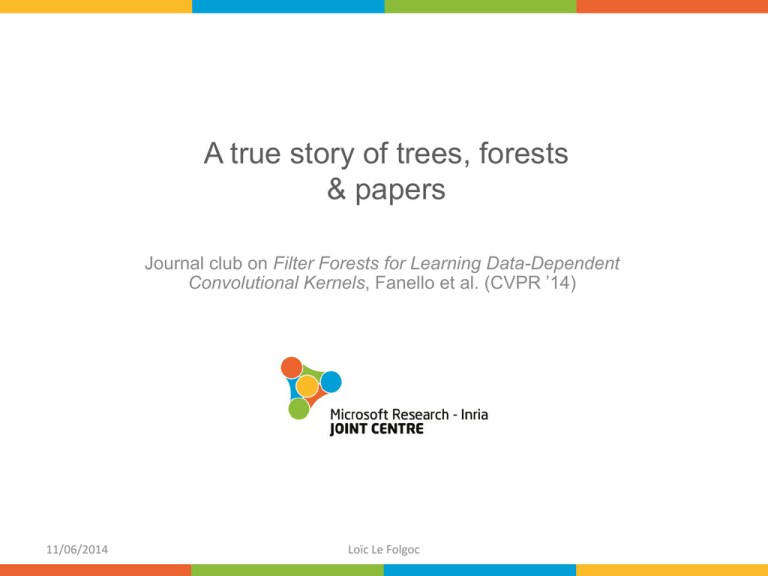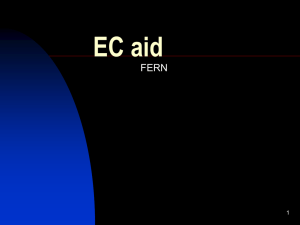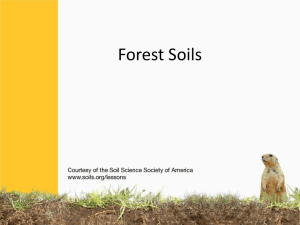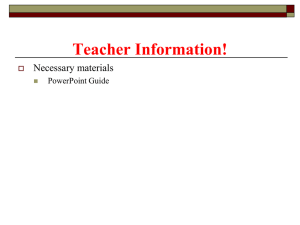Decision forests
advertisement

A true story of trees, forests
& papers
Journal club on Filter Forests for Learning Data-Dependent
Convolutional Kernels, Fanello et al. (CVPR ’14)
11/06/2014
Loïc Le Folgoc
Criminisi et al. Organ localization w/ long-range spatial context (PMMIA 2009)
Miranda et al. I didn’t kill the old lady,
she stumbled (Tumor segmentation in
white, SIBGRAPI 2012)
Montillo et al. Entangled decision forests (PMMIA 2009)
Kontschieder et al. Geodesic Forests (CVPR 2013)
Shotton et al. Semantic texton forests (CVPR 2008)
Gall et al. Hough forests
for object detection (2013)
Girshick et al. Regression of human pose,
but I’m not sure what this pose is about (ICCV 2011)
Geremia et al. Spatial decision forests for Multiple Sclerosis lesion segmentation (ICCV 2011)
Margeta et al. Spatio-temporal forests for LV
segmentation (STACOM 2012)
Warm thanks to all of the authors, whose permission for image reproduction I certainly did not ask.
Decision tree:
Did it rain over the night? y/n
Is the grass wet?
Decision rules
Yes.
No.
Leaf model
Did you water the grass?
Yes.
No.
Y N
Y N
•
•
Y N
Descriptor / input feature vector:
𝑣 = (yes the grass is wet, no I didn’t water it, yes I like strawberries)
Binary decision rule: [𝑣𝑖 == true], fully parameterized by a feature 𝜃 = 𝑖
Decision tree:
Did it rain over the night? y/n
Do you like strawberries?
Yes.
Y
•
•
•
N
No.
Y
N
We want to select relevant decisions at each node, not silly ones like above
We define a criterion / cost function to optimize: the better the cost, the more the
feature helps improve the final decision
In real applications the cost function measures performance w.r.t. a training
dataset
Decision tree:
Training phase
𝜃1∗
𝑓 𝜃1∗ ,⋅ ≥ 0
𝑓 𝜃1∗ ,⋅ < 0
𝜃2∗
𝑙2
𝑙1
𝑙3
•
•
•
Training data 𝐗 = (𝒙1 , ⋯ , 𝒙𝑛 )
Decision function: 𝒙 → 𝑓(𝜃𝑖 , 𝒙)
𝜃𝑖∗ = argmin ℰ(𝜃𝑖 , 𝐗 𝑖 ) where 𝐗 𝑖 is the portion of training data reaching this node
•
𝑙𝑘 parameters of the leaf model (e.g. histogram of probabilities, regression function)
𝜃𝑖 ∈Θ𝑖
Decision tree:
Test phase
𝒙
𝜃1∗
𝑓 𝜃1∗ , 𝒙 = 3 ≥ 0
𝑓 𝜃2∗ , 𝒙 = 1 ≥ 0
𝜃2∗
𝑙2
𝑙1
𝑙3
Use the leaf model 𝑙2 to make your prediction for input point 𝒙
Decision tree:
Weak learners are cool
Decision tree:
Entropy – the classic cost function
•
For a k-class classification problem, where 𝑐𝑖 is assigned a probability 𝑝𝑖
Ε 𝑝 =−
𝑝𝑖 log 𝑝𝑖
𝑖
•
•
Ε 𝑝 = Ε𝑝 [− log 𝑝] measures how uninformative a distribution is
It is related to the size of the optimal code for data sampled according to 𝑝 (MDL)
Ε=0
Y
•
Ε = log 2
Y
N
N
For a set of i.i.d. samples 𝑋 with 𝑛𝑖 points of class 𝑐𝑖 , and 𝑝𝑖 = 𝑛𝑖 / 𝑖 𝑛𝑖 , the entropy is related to
the probability of the samples under the maximum likelihood Bernoulli/categorical model
𝑛 ⋅ Ε 𝑝 = − log max 𝑝(𝑋|𝑝)
𝑝
•
Cost function: ℰ 𝜃, 𝐗 =
𝐗 𝑙,𝜃
𝐗
Ε 𝑝 𝐗 𝑙, 𝜃
+
𝐗 𝑟,𝜃
𝐗
Ε 𝑝 𝐗 𝑟, 𝜃
Random forest:
Ensemble of T decision trees
Train on subset 𝐗1
Train on subset 𝐗 2
Train on subset 𝐗 𝑇
⋯
Optimize over a subset of
all the possible features
1
Define an ensemble decision rule, e.g. 𝑝(𝑐|𝒙, Τ) = 𝑇
𝑇
𝑖=1 𝑝(𝑐|𝒙, 𝑇𝑖 )
Decision forests:
Max-margin behaviour
1
𝑝(𝑐|𝒙, Τ) =
𝑇
𝑇
𝑝(𝑐|𝒙, 𝑇𝑖 )
𝑖=1
A quick, dirty and totally accurate story of
trees & forests
•
Same same
–
–
–
–
•
Quick history
–
–
–
–
•
CART a.k.a. Classification and Regression Trees (generic term for ensemble tree models)
Random Forests (Breiman)
Decision Forests (Microsoft)
XXX Forests, where XXX sounds cool (Microsoft or you, to be accepted at the next big conference)
Decision tree: some time before I was born?
Amit and Geman (1997): randomized subset of features for a single decision tree
Breiman (1996, 2001): Random Forest(tm)
• Boostrap aggregating (bagging): random subset of data training points at each node
• Theoretical bounds on the generalization error, out-of-bag empirical estimates
Decision forests: same thing, terminology popularized by Microsoft
• Probably motivated by Kinect (2010)
• A good overview by Criminisi and Shotton: Decision forests for Computer Vision and Medical Image Analysis
(Springer 2013)
• Active research on forests with spatial regularization: entangled forests, geodesic forests
For people who think they are probably somewhat bayesian-inclined a priori
–
–
Chipman et al. (1998): Bayesian CART model search
Chipman et al. (2007): Bayesian Ensemble Learning (BART)
Disclaimer: I don't actually know much about the history of random forests. Point and laugh if you want.
Application to image/signal denoising
Fanello et al. Filter Forests for Learning DataDependent Convolutional Kernels (CVPR 2014)
Image restoration:
A regression task
Noisy image
Denoised image
Infer « true » pixel values using context (patch) information
Filter Forests:
Model specification
•
•
Input data / descriptor: each input pixel center is
associated a context, specifically a vector of
intensity values 𝐱 in a 11 × 11 (resp. 7 × 7, 3 × 3)
neighbourhood
Node-splitting rule:
–
–
preliminary step: filter bank creation
retain the 10 first principal modes 𝒗𝑖,𝑘 from a PCA
analysis on your noisy training images;
(do this for all 3 scales, 𝑘 = 1,2,3)
1st feature type: response to a filter
[𝐱 𝑡 𝒗𝑖,𝑘 ≥ 𝑡]
–
2nd feature type: difference of responses to filters
[𝐱 𝑡 𝒗𝑖,𝑘 − 𝐱 𝑡 𝒗𝑗,𝑘 ≥ 𝑡]
–
3rd feature type: patch « uniformity »
[Var(𝐱) ≥ 𝑡]
𝐱 = (𝑥1 , ⋯ , 𝑥𝑝2 )
𝐱 = (𝑥1 , ⋯ , 𝑥𝑝2 )
Filter Forests:
Model specification
•
Leaf model: linear regression function (w/ PLSR)
𝑓: 𝐱 → 𝑓 𝐱 = 𝒘∗ 𝑡 𝐱
𝛾𝑑 𝐗 𝑒 , 𝐲𝑒 𝒘2𝑑
𝒘∗ = argmin ‖𝐲𝑒 − 𝐗 𝑒 𝒘‖2 +
𝒘
•
𝑑≤𝑝2
Cost function: sum of square errors
ℰ 𝜃 =
𝑐∈{𝑙,𝑟}
•
Feature 𝜃
|𝐗 𝑒 𝑐, 𝜃 |
‖𝐲𝑒 𝑐, 𝜃 − 𝐗 𝑒 𝑐, 𝜃 𝒘∗ 𝑐, 𝜃 ‖2
|𝐗 𝑒 |
Data-dependent penalization 𝛾𝑑 𝐗 𝑒 , 𝐲𝑒
–
–
–
Penalizes high average discrepancy over the training set
between the true pixel value (at the patch center) and the
offset pixel value
Coupled with the splitting decision, ensures edge-aware
regularization
Hidden link w/ sparse techniques and bayesian inference
Left child
Leaf model 𝒘𝑙
Right child
Leaf model 𝒘𝑟
Filter Forests:
Summary
Input
𝐱 = (𝑥1 , ⋯ , 𝑥𝑝2 )
PCA based split rule
Edge-aware convolution filter
Dataset on which they perform better than the others
Cool & not so cool stuff about decision
forests
•
•
•
•
•
•
•
Fast, flexible, few assumptions, seamlessly handles various applications
Openly available implementations in python, R, matlab, etc.
You can rediscover information theory, statistics and interpolation theory all the time and nobody
minds
A lot of contributions to RF are application driven or incremental (e.g. change the input
descriptors, the decision rules, the cost function)
Typical cost functions enforce no control of complexity: the tree grows indefinitely without “hacky”
heuristics → easy to over fit
Bagging heuristics
Feature sampling & optimizing at each node involves a trade-off, with no principled way to tune
the randomness parameter
–
–
•
No optimization (extremely randomized forests): prohibitively slow learning rate for most applications
No randomness (fully greedy): back to a single decision tree with a huge loss of generalization power
By default, lack of spatial regularity in the output for e.g. segmentation tasks, but active research
and recent progress with e.g. entangled & geodesic forests
The End \o/
Thank you.






